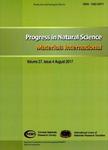Sedimentary environments of the Cenozoic sedimentary debris found in the moraines of the Grove Mountains, east Antarctica and its climatic implications
Sedimentary environments of the Cenozoic sedimentary debris found in the moraines of the Grove Mountains, east Antarctica and its climatic implications作者机构:Korea Korea Ocean Research and Development Institute Ansan P.O. Box 29 Seoul 425 600
出 版 物:《Progress in Natural Science:Materials International》 (自然科学进展·国际材料(英文))
年 卷 期:2004年第3期
页 面:31-42页
学科分类:0709[理学-地质学] 081803[工学-地质工程] 07[理学] 08[工学] 0818[工学-地质资源与地质工程]
基 金:SupportedbytheNationalNaturalScienceFoundationofChina(GrantNo .40 2 0 2 0 3 4)andKOSEF andtheMinistryofScienceandTechnologyofChina (GrantNo .98 92 7 0 1 0 6)
主 题:Grove Mountains east antarctica diamicton sedimentary environments climatic change.
摘 要:During the field work of the 1998~1999’s and 1999~2000’s Chinese National Antarctic Research Expedition (CHNARE) in the Grove Mountains, east Antarctica, some Cenozoic sedimentary debris are found in two terminal moraine banks over the blue ice near Harding Mount in the center of this region. All the debris are of characteristics of glaciogenic diamicton and belong to the products of the glacial movements of the East Antarctic Ice Sheet. In this paper, the authors make a detailed study on the sedimentary environments of the sedimentary debris through petrologic, sedimentological, mineralogical, and geo chemical methods. Characteristics of their sedimentary textures and structures, grain size distributions, quartz grains’ surface textures and features, together with their geo chemical compositions all show that these sedimentary rocks are a kind of subglacial lodgement tills which are deposited in the ice sheet frontal area by reactions of glacial movements and glaciogenic melt water. Their palaeoenvironmental implications in revealing the retreat history of East Antarctic Ice Sheet are discussed. The authors draw the conclusion from current study that the glacial frontal of the East Antarctica Ice Sheet might have been retreated to this area during the Pliocene Epoch, which represents a warm climate event accompanied by a large scale ice sheet retreat in Antarctica at that time.



